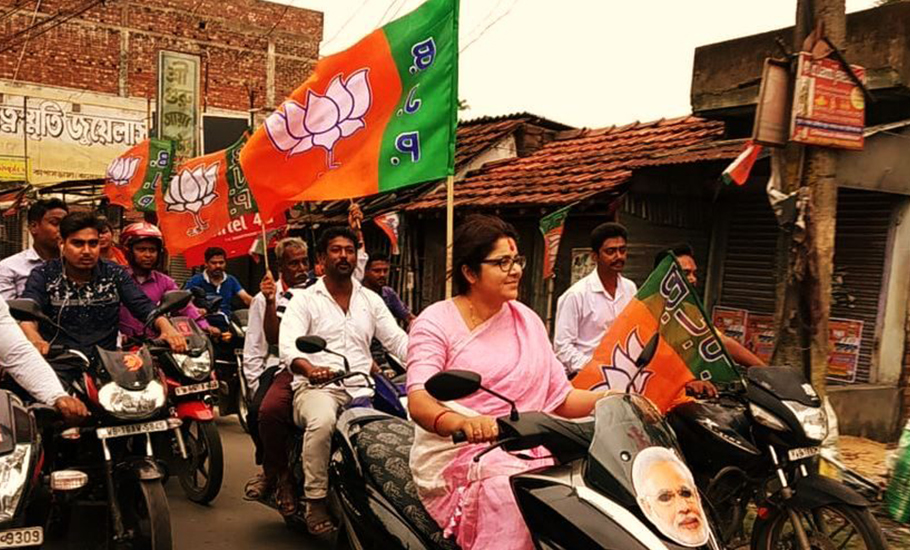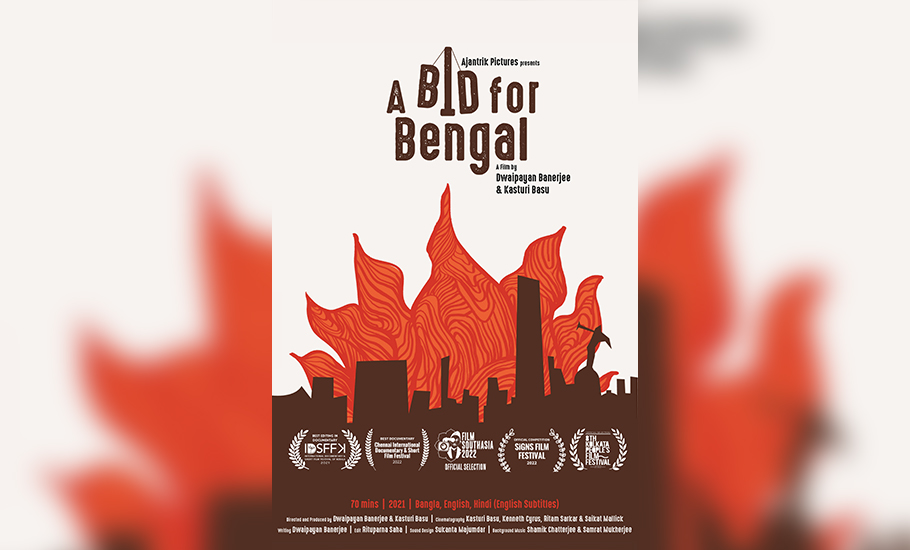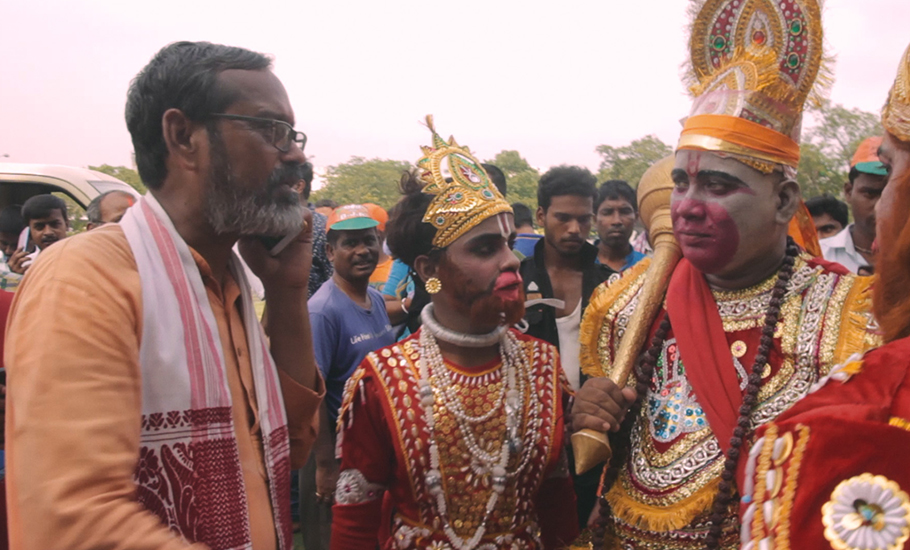
- Home
- News
- Analysis
- States
- Perspective
- Videos
- Education
- Entertainment
- Elections
- World Cup 2023
- Features
- Health
- Business
- Series
- Economy Series
- Earth Day
- Kashmir’s Frozen Turbulence
- India@75
- The legend of Ramjanmabhoomi
- Liberalisation@30
- How to tame a dragon
- Celebrating biodiversity
- Farm Matters
- 50 days of solitude
- Bringing Migrants Home
- Budget 2020
- Jharkhand Votes
- The Federal Investigates
- The Federal Impact
- Vanishing Sand
- Gandhi @ 150
- Andhra Today
- Field report
- Operation Gulmarg
- Pandemic @1 Mn in India
- The Federal Year-End
- The Zero Year
- Premium
- Science
- Brand studio
- Home
- NewsNews
- Analysis
- StatesStates
- PerspectivePerspective
- VideosVideos
- Entertainment
- ElectionsElections
- Sports
- Loading...
Sports - Features
- BusinessBusiness
- Premium
- Loading...
Premium

How a filmmaker couple explored Bengal’s long affair with Hindutva

The chants of ‘Jai Shri Ram’ that have been raised across Bengal ubiquitously in the recent past, including in front of mosques, led many to ask how the state has suddenly acquired saffron shades despite a three-decade long rule of the Left Front headed by the CPM. But Hindutva and communalism have a long history in the region. Nineteenth-century Bengal, which was the theatre of...
The chants of ‘Jai Shri Ram’ that have been raised across Bengal ubiquitously in the recent past, including in front of mosques, led many to ask how the state has suddenly acquired saffron shades despite a three-decade long rule of the Left Front headed by the CPM.
But Hindutva and communalism have a long history in the region. Nineteenth-century Bengal, which was the theatre of the Indian Renaissance and from where many aspects of modern India originated, was also the birthplace of the idea of Hindutva. The word Hindutva itself was a product of Bengal much before it spread across the country and came to be associated with right-wing groups.
Hindu revivalism, historians point out, emerged in the state in the second half of the 19th century as a reaction to the influence of Western education and culture on the Hindu society during the first half of the century. As the Left began to rule the state, much of the gains of Hindu revivalism began to gather dust. Under Mamata Banerjee, the status quo remained even as Sangh affiliates began eking out a space for Hindutva reassertion.
Then what led to the recent phenomenal growth of Hindu-nationalist politics and communal polarisation in West Bengal? An activist-filmmaker couple finds the answer to this bloom of the lotus in Bengal through a documentary called A Bid for Bengal. The duo shot the documentary between two elections – the national elections of 2019 and the state assembly polls of 2021.
With a camera, Dwaipayan Banerjee and Kasturi Basu visited cow-protection cells, Ram Navami processions, Hindu nationalist radicalisation camps, the IT cell office of the BJP, and riot-torn landscapes, to expose the underbelly of the Hindu-nationalist project in Bengal. The job, however, was challenging.

“One of the main challenges was, of course, getting access to Sangh Parivar activists, the IT cell workers, and interviewing and shooting their activities. But we got a bit lucky with getting access because we were shooting during the election campaign phase,” said Kasturi. Another big challenge that the couple faced was the Covid-induced lockdown which affected their shooting and post-production. “We neither had a big budget nor a producer. Several friends and well-wishers came forward to support the film in its various stages. The shooting was done on a shoestring budget, so we had to improvise a lot,” she added.
The couple said while they grew up in Kolkata and are familiar with the state’s cultural moorings, they never witnessed a Ram Navami procession on the scale and in the manner in which it is seen today. “We wanted to expose the old historical fault lines of a broken Bengal that made possible the current gains of the Hindu-nationalist project in a land divided by the 1947 partition,” said Kasturi, who along with Dwaipayan, has been screening documentaries across West Bengal since they launched People’s Film Collective (PFC), an independent, autonomous, people-funded cultural-political collective in 2013.
The PFC believes in the power of films as a weapon of pedagogy for the oppressed as well as alternative media for people. It organises monthly film screenings in Kolkata. It travels in Bengal with films and movement videos. Its members document movements and make political documentaries. PFC organises an annual film festival, Kolkata People’s Film Festival, and brings out a magazine Pratirodher Cinema. Bengal, according to them, was a land shared by nearly as many Hindus as Muslims, but today, seven decades after Partition, both sides have increasingly become majoritarian community spaces where minority communities have been made to feel vulnerable. “We are trying to tell the history of Hindu-nationalist politics in West Bengal from the distant past to the immediate present through this film.”
The couple has shown through their 70-minute-long film that the seed of Hindutva politics was always there in West Bengal, and Sangh Parivar affiliates had been working diligently for a long time in the state. “After 2014, with their increased hegemonic presence all over India, they have gained strength in many other states where they had very little presence. In Bengal, they had filled the political vacuum after the gradual weakening of CPM, and the Congress. The BJP stepped into this vacuum to become the principal electoral opposition to the TMC, whereas the Sangh Parivar tried to increase their influence by rubbing salt into the injuries of refugees of the Partition of Bengal,” said Dwaipayan.

What led to the gradual decimation of the CPIM-led Left Front in West Bengal? “They [the Left Front] had taken no lesson from their wrongs in Singur and Nandigram. During the latter part of their regime, they had shifted from social democratic practices that had ensured a solid support base for them in the rural pockets of Bengal. Even after they had been voted out of power, they had done nothing much to counter the populist politics of the Trinamool Congress (TMC) in Bengal,” said Kasturi. “Apart from a severe leadership crisis, they have failed to reinvent themselves, and there seems to be no immediate prospect of their revival,” she added. Kasturi’s earlier documentary titled SD: Saroj Dutta and his Times (2018) exposed the story of the communist revolutionary and poet Saroj Dutta’s forced disappearance from Kolkata in 1971.
A Bid for Bengal, the couple said, is a warning to the people that although we have got a temporary respite with the defeat of the BJP in the 2021 election in the state, the war is far from over. According to Kasturi and Dwaipayan, the BJP’s agenda of “subverting the constitutional values, and changing the secular, and federal nature of the Indian state continues unabated”. It’s also a warning call to the democracy-loving people of those states in the Indian union that have yet to be won over by them, they added. As a student activist, Dwaipayan had participated in the Singur and Nandigram protests in 2006-2007. Kasturi had been teaching physics at St Xavier’s College, Kolkata.
Kasturi and Dwaipayan said they would like to screen A Bid for Bengal as widely as possible. “If it (the documentary) resonates with them and creates a dialogue, then that would be the relevance of the film.” The couple have been influenced by the Third Cinema movement in Latin America and Odessa Collective of the cult filmmaker John Abraham (1937–1987). Both cinema and politics can mean many things to many people. “It’s not homogenous and neither should it be. Our entry point in working with the medium of cinema would be to raise relevant issues and to build alternative forms of pedagogy for the oppressed.” Apart from the People’s Film Collective, the couple has been active in the anti-National Register of Citizens (NRC) campaign as well. Besides, the two have been active participants in the ‘No Vote to BJP’ campaign. “All this has shaped our films in more ways than one.”

